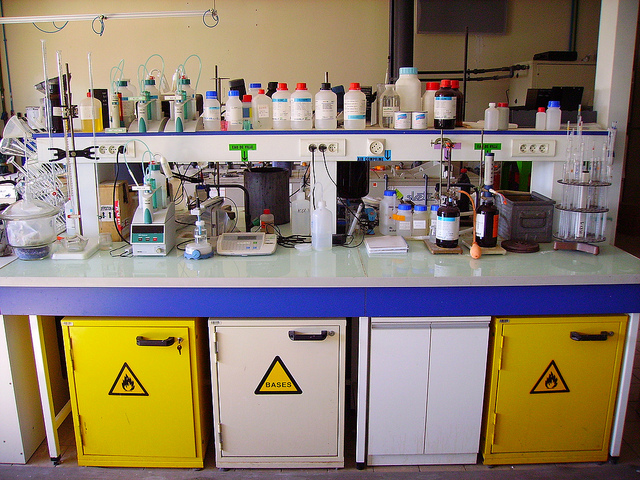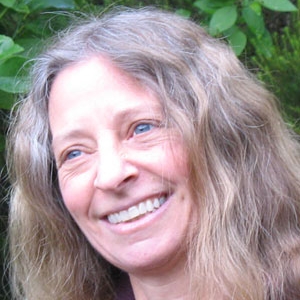
Any science story depends on getting the facts and figures right. But visiting scientists where they work allows you to move beyond the facts to glean insights into their personalities and passions. A lab visit can reward the enterprising reporter with behind-the-scenes details about how a discovery was made and what motivates the people doing the work.
But getting the most out of a lab visit is a skill unto itself. Many science journalists I know began their careers as bench scientists with intimate knowledge of lab work and all that goes with it. But with a background in political science, I had no occasion to visit a research lab until I started writing for a science museum nearly 15 years ago. Like a lot of other science writers, I’ve learned on the job—though not without a few missteps. I’ll never forget one of my first lab visits, when my overstuffed backpack nearly toppled an outsized glass Erlenmeyer flask in Pat Brown’s Stanford University biochemistry lab. I quickly stashed my pack in a corner, grabbed my notebook and pen, and resumed the lab tour, heart racing, hoping no one had noticed.
Watch Your Step
That early close call highlights a central element of any laboratory visit: Most labs have fragile equipment lying around and sensitive instruments recording experimental results. It may seem blazingly obvious that you should be extremely careful not to break anything or interfere with the work at hand. But labs can be cramped, cluttered, and chaotic. And when you’re juggling notebooks, pens, cameras, and recorders, it’s easy to get distracted. The last thing you want to do is bump into someone who’s in the middle of a delicate procedure or place your gear on a finely calibrated instrument. Pay attention to what’s going on around you, and you’ll be fine.
Book Enough Time
I usually ask for more time than I think I’ll need at a site—which, depending on the type of story I’m doing, could be anywhere from one to several hours. You should respect your source’s time, but your first priority is to get good material for your story. If I notice my time’s up but the person I’m interviewing doesn’t appear antsy, I’ll keep asking questions until I’m told it’s time for me to go.
Do Your Homework
Before you go, look for published stories about your sources and the work that’s come out of their lab. You don’t want to bother covering old ground, unless doing so provides helpful background material. Plus, an earlier story might mention a scientist’s future research plans, so you can ask how the work panned out. And if a scientist complains about how another journalist got something wrong, you’ll be prepared to delve deeper into the problem and perhaps pursue an unexplored angle you hadn’t thought of.
Meeting researchers at their labs gives you the chance to chat as they’re showing you around, allowing you to discover interesting tidbits about their lives or personalities. But remember that researchers are busy. Don’t waste time asking them something you could easily learn in a textbook. And make sure you read up on your source’s work. If you’re conversant in the research, the interview will likely be more relaxed, leading to richer material and better quotes.

Before traveling to Brooke Army Medical Center in San Antonio to interview top Army surgeon Colonel Robert Hale for a Discover story on war and medicine, I read extensively about historical and recent advances in helping soldiers with horrific facial injuries. When I met Hale, a decorated, high-ranking officer on an extremely tight schedule, he seemed impressed that I’d done my homework. We chatted about milestones in military medicine, which he clearly had a passion for. And though I knew that much of what we discussed wouldn’t end up in the story, the chat broke the ice. I felt more comfortable broaching some of the more sensitive issues I needed to explore for the story, not just about facial trauma but also about the colonel’s personal history and motivations.
My advance preparation also assured him that he could introduce me to his team members without worrying that I would waste their valuable time.
Before making a lab visit, Deborah Blum, a Pulitzer Prize–winning journalist who teaches journalism at the University of Wisconsin–Madison, routinely searches Google Scholar for papers on her topic, then does a similar search on the scientists she plans to interview.
“The thing to remember about an on-the-ground lab visit is that you want to ask questions based on your homework but you also want to pay attention to what’s around you and let that color the interview too,” Blum says. After Dartmouth toxicologist Brian Jackson’s work on arsenic in rice-based baby formulas and other products had caught Blum’s attention, she went to his lab for a Discover story about arsenic in rice.
“Being in the lab let me see how obsessively organized he was,” says Blum, who had to wear protective footwear for the tour. “Every drawer labeled, everything in its place, everything shining clean. But when I was there, I discovered that even with all his organizational skills, the place was still overflowing with cans of baby formula. They were stacked up in cabinets. They spilled into his office. I asked him to count them for me. And I used that, the formula cans taking over his life, to set up my story. I always thought of them like that scene from ‘The Sorcerer’s Apprentice’ with the ever-multiplying mops and brooms.”
Capture Sensory Details
In-person visits can offer unmatched opportunities to spot revealing aspects of researchers’ personalities, habits, workspaces, and styles of interacting with others. For a story on James Watson, who shared the Nobel Prize with Francis Crick for discovering DNA’s structure in 1953, Bryn Nelson felt an interview at the legendary biologist’s office was essential.
“To my delight, his office proved to be a great reflection of the anachronistic researcher,” says Nelson, a freelance journalist who worked for Newsday at the time. “He had one of the first models of the DNA double helix on his desk, and also a pinup calendar.”
The visit also allowed Nelson to capture Watson reading from his famous paper:
He steps around his desk, retrieves a copy of the original paper and reads the last sentence aloud: “It has not escaped our notice that the specific pairing we have postulated immediately suggests a possible copying mechanism for the genetic material.”
And then he giggles.
In writing that scene, complete with Watson’s giggle, Nelson revealed a mischievous if faintly smug side of Watson, who half a century later delighted in deploying monumental understatement to describe one of science’s most celebrated discoveries. It’s also telling that Watson had the paper so close at hand for the interview.
Whenever I meet scientists in the lab or out in the field, I take a camera to capture visual details that might add color to a story. Some people ask questions that aren’t relevant to the story so they can snap away without worrying about missing key points. I try to wait for breaks in the conversation, perhaps while moving from one station in the lab to another. You may think you’ll easily remember what a person looks like after spending a few hours with them, but mental images can fade quickly, especially after a full day of reporting.
If I notice any surprising or noteworthy sensory elements as someone’s talking, I jot them down along with the time stamp on my audio recorder. Then when I’m ready to start writing, I compare the transcript with my notes and review the photos to jog my visual memory, to see if the sensory details I’ve captured add depth or nuance to what the person was saying.
Nelson relies on the intent of the story to decide what visual elements to focus on. “I try to capture details that offer a bit of color, humanity, or an unexpected aspect to the researcher’s work,” he says. “These visual reminders are great when I’m going over my notes and trying to recapture the moment for readers.”
Just remember, if you take audio recorders, cameras, or other multimedia equipment, make sure to bring extra batteries, memory cards, and chargers. It’s easy to become complacent when you’re used to doing phone interviews and have everything you need within arm’s reach. You don’t want to discover that your batteries died just as your source was leaning in to tell you a particularly juicy tale.
Schedule for Drama
Years ago, I heard Mark Kramer, founding director of the Nieman Program on Narrative Journalism at Harvard University, talk about how he finds the material to write compelling nonfiction stories. “When you call for an interview appointment and a source says, ‘Oh I’m really busy that day,’ don’t say, ‘Oh what’s a better day?’ Say, ‘What are you doing and can I come?’”
Sources don’t know what sorts of opportunities you’re looking for. You have to tell them. Maybe they’re trying a new technique and think you wouldn’t be interested in visiting that day because it might not work. But what qualifies as a setback for a researcher can make good drama for a writer. Assure them that you’ll be as unobtrusive as possible as you watch them in action.
Then, as you observe any dramatic moments, note everything around you—people, equipment, accidents—using all your senses. Look for details that foster a reader’s sense of immediacy, that place them in the room with you.
Meet the Team
Sources may suggest that you visit when most people aren’t around, assuming you’d prefer to conduct an interview with fewer distractions. But if you go when no one’s in the lab, you’ll lose the chance to see how your source interacts with colleagues, which might have bearing on the work.
Meeting other people in the lab also gives you a chance to observe the working environment and get a feel for how lab members view your source. Is the atmosphere congenial? Do you sense tension or stress? Do younger researchers seem deferential or appear to treat the lab head with disdain? Any of these details can help you flesh out a person’s character to build a lively portrait.
Even if you’re profiling a single researcher, science is rarely a singular effort, especially these days. In biomedical research, it’s usually the first author on a paper who designed the study or led the research. Make a point of asking to meet that person and any others who played a role in the work you’re writing about. If someone developed a new method or piece of equipment to do the experiments, ask if they can demonstrate its advantages. And make sure you ask what they’re working on now, which could suggest leads for future stories.
Take the Long View
Journalists are nothing without their sources. And face-to-face meetings help build lasting connections. “Nothing builds relationships like an in-person visit,” says Blum. “The smart journalist also uses the lab visit to connect with people so that you can come back to them. In the Dartmouth visit, I talked to a lot of Jackson’s colleagues and later I was able to do two different stories for The New York Times related to the work of other scientists I’d met. And I got invited to an international meeting on arsenic in Maine and made even more connections. So the visit is not just an endpoint.”

Liza Gross is a freelance journalist and science editor at PLOS Biology. She writes mostly about wildlife conservation, health, and environmental issues. Her story “Don’t Jump!,” published in Slate, won the 2014 ASJA award for outstanding op-ed. She’s a 2013 recipient of the NYU Reporting Award and the Dennis Hunt health journalism fellowship. Follow her on Twitter @lizabio.


